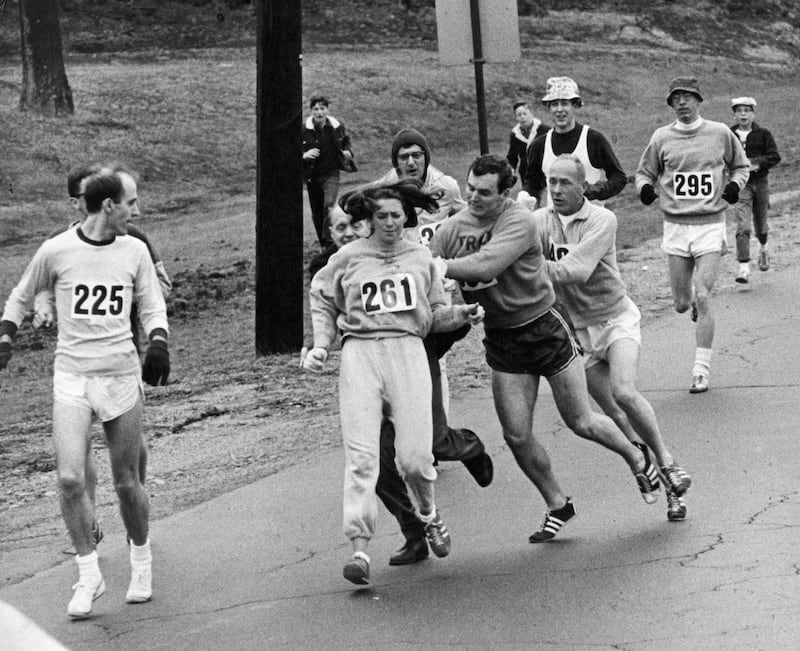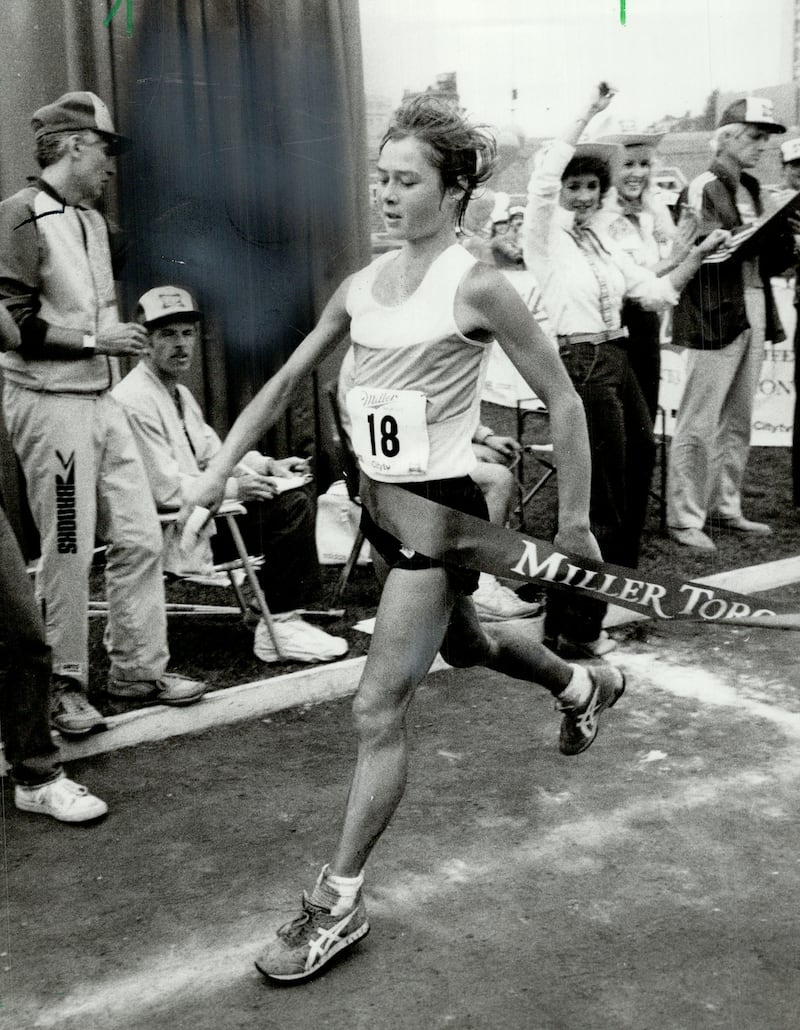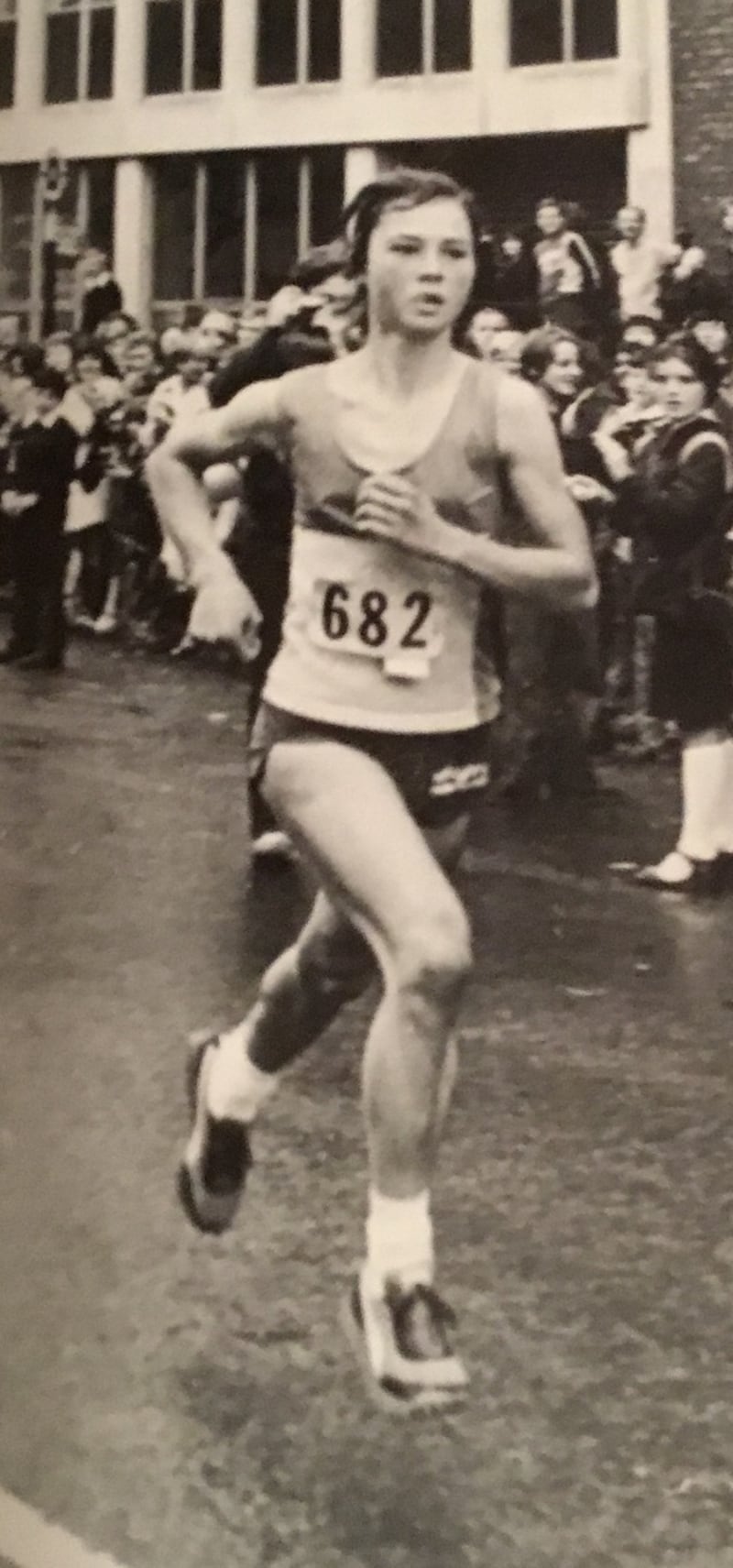The miles are flying by. There can only be one winner of the first Dublin Marathon, and Carey May is at the front of the women’s race, within an eye and ear of the first finish line.
People on the roadside to her left and right become one and then two deep. Off in the near distance comes the sound of the endgame at St Stephen’s Green and the history that only once beckons.
“At no point do you think or realise the significance of it,” May recalls, as if suddenly taken back to that bank holiday Monday in Dublin, October 1980. “I still remember the excitement that morning, because for the vast majority on the start line, it was their first ever marathon. That sense of unknown, intrigue, was just fantastic.
“I certainly remember it being hard, and somewhere around the 20-mile mark, near Donnybrook, my clubmate at Dublin City Harriers, Roy Dooney, yelling at me, ‘You’re on 2:40-pace, keep it going’. And you just keep ticking off the miles, ticking off the miles.”
Even by that point, few Irish women had ever run so far or so fast. May had just turned 21, a novice by all distance-running standards, but like any pioneer in any new adventure, it’s not the uncertainty that drives her on: it’s what lies beyond.
“It was like that, running into the unknown. And it was a very different challenge back then. It was so unscientific, and we probably weren’t preparing correctly at all, at least compared to these days. No clue about pacing, or times. And there weren’t any women running marathons in Ireland, maybe just one or two. I assume I thought there were other women in the race, and I know it sounds bad, but I was always very annoyed if there were any women ahead of me. I wanted to be the first.”
With two miles to go, another obstacle appeared: “I just remember this old guy running out in front of me, shouting ‘What are doing? Women shouldn’t be doing this!’ But it was nothing I dwelled on. I just kept going. He’d probably come out of a pub or something, I don’t know.
“It was difficult, but when the focus is so strong, you don’t let it get to you. It was around mile 24, when he ran across me, and it threw me for maybe a minute. But I just thought, Get away from me, you can’t do this right now, and that was it. You’re giving it everything, the focus is so strong, but it was a shaky spot. Thankfully I was so close to the finish, but I didn’t even think about it. I just shut it out. You’re used to dealing with things out running. You can’t dwell on it.”
Forty years on
Easier said than done, but May refused to dwell or bring any further attention to the incident at that time. Only now, on the eve of the 40th Dublin Marathon, does it give further perspective on just how different a time it was. Over a decade after Kathrine Switzer overcame a similar obstacle to become the first registered woman to finish the Boston Marathon, some people still believed this was a test of endurance only suitable for men.

“I didn’t want to give him any more attention or publicity. I actually recall more encouragement than resistance at the time. Or else disbelief: people rolling their eyes when you told them what you were going to do. And I was very hard-headed. If there was something I was told you couldn’t do, I’d say, ‘Right, I’ll do it’.
“It was also such an exciting time to be around Irish distance running, and Dublin was the first big mass involvement event in Ireland. At that point in time you didn’t think too much about it. You just went out and did it. We just ran as hard as we could, for as long as we could, wearing a basic stopwatch, until we couldn’t run any more. And it was fantastic. I think the innocence of it all was something magic.”
May still has a race to win and a promise to keep. Her marathon naivety includes wearing a brand new pair of runners, and nothing is certain until she hits that first finish line, where her winning time of 2:41:11 is over 20 minutes ahead of the next-best woman, Mary Walsh, who runs 3:02:27.
“Coming into the finish, on St Stephen’s Green, I don’t think I’ve ever experienced anything like it – the excitement, the exhilaration, being so exhausted, but knowing you’re at the end. Nothing really came close to that again. The crowds were so just encouraging, but again we didn’t appreciate the magnitude of it all, what it all meant.”
Etched in history
Along with Dick Hooper, the first men’s winner in 2:16:14, her name will be etched in Dublin Marathon history. That Monday in October marked a series of marathon and distance running firsts for May: a year later, she would win the first women’s National Marathon title, running 2:42.39; and in 1982, she would run for Ireland in the first European Championship marathon for women, in Athens.
May didn’t stop there: in 1983, she ran the first World Championship marathon for women in Helsinki, finishing 13th in 2:36:28, and better again ran the first Olympic Marathon for women in Los Angeles in 1984. These were proper pioneering days for women’s marathon running and May played a part in almost all of them.
Winning Dublin in 1980 also sent May on another adventure: a year later she was offered a scholarship to Brigham Young University in Provo, Utah, the sprawling Mormon campus that also provided the foundation for yet further running success, May twice winning the Osaka International Marathon for women, in Japan, her winning time in 1985 of 2:28:07 standing as the Irish record for 12 years, before Catherina McKiernan finally bettered it with her 2:23:44 in Berlin.

“It did change my life, completely, put me on that running career. I was out of school a few years, wasn’t really intending on going to university. There was no social media, none of the publicity you have now, but the coach at BYU, Patrick Shane, called me up on the back of Dublin, and some other cross-country races, and I got the chance to go the US, to focus on running and study, and also the first time women got to compete in all the NCAA competitions, which was amazing – completely brought me on.
“Being in Utah, in the mountains, it was beautiful, and everything that suited me. One phone call home a month, and you just got on with it. And that was all on the heels of the Dublin Marathon.”
Not a million miles either from the foothills of the Dublin mountains, where May grew up and got her first taste of adventure. She was born in Portsmouth in 1959, before her family moved to Dublin when she was 11, settling in Ticknock. Her parents still live just past the forest gate entrance. At school in nearby Wesley College, she tried a variety of sports before orienteering became her first passion.
“I was always very independent, and I think half the time my parents didn’t know what we were doing. We’d go off orienteering for the weekend, or off to the Continent. I think having three brothers, I was always out to prove myself. I was headstrong, after, but I was never the top athlete before then. I had done some hurdles, some cross-country. Our longest race at that point was 3,000m on the track. And some people thought that was far.”
‘Completely clueless’
As crazy as it sounds now, the marathon seed was first planted just months before Dublin, when May witnessed the 1980 National Marathon in Tullamore. That August the Ulster Open Marathon was staged in Letterkenny, and May was the first woman among the 45 finishers, her 2:53:18 the first time any Irish woman had run under three hours.
She was working as a computer data processor in UCD, and this was uncharted terrain. “I’d done 20-mile runs, and thought, How much harder could it be? But we really were completely clueless. I remember Jim Dowling, a great proponent of women’s running, asking what time I thought I could run. I said I’d like to break three hours, and he thought I was kidding.

“I’d also surrounded myself with like-minded people, the likes of Deirdre Nagle, Mary Purcell, all my heroes back then. That competitive drive brought the times as well, because we just competed. And always great fun. And so many incredible opportunities came out of it.”
After graduating from BYU (her college 10,000m record of 32:51 still stands, 35 years later), May settled in Canada. She married in 1985; her twin sons turn 32 this week. She later moved to Texas, Washington state, then California, and after her divorce seven years ago, now lives in Chicago, where she coaches high school athletics and still enjoys her daily running routine.
“There wasn’t really the opportunity to run Dublin again, and that’s maybe one of my regrets. Also, the championship marathons were never great for me, because they all came after a long college season, and that was always a trade-off. But I wouldn’t change anything. Winning is Osaka, twice, was unbelievable, where the fan base is quite ridiculous.
“And all strictly amateur; you couldn’t take a penny. It’s all so different now, so many people running marathons, over 20,000 in Dublin, which is fantastic, because the accomplishment doesn’t change, no matter how you do it.
“It just seemed more innocent back then, no prize money, just a plaque, and maybe a medal. And no second-guessing any performances, like we have now. Back then in the marathon there was nothing we could take, really. Just sipping on the cups of water. Some runners may have had Gatorade at the time, but that was just a distraction for me.
“The last marathon I ran, I didn’t quite break three hours, and I said that’s it, I’m finished. I prefer to run on the trails now. Because I still think there is nothing better for your mental health, the freedom of it, and so grateful I can still run. And still the precious memories of Dublin, just to be a part of the first one, a great sense of pride. You can’t ever repeat moments like that.”



















